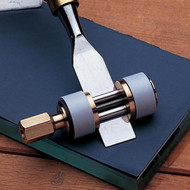A saw which has been in use for a long time or been abused will need topping, shaping, setting, or sharpening.
However, it is treated carefully, a saw will have been sharpened several times before any or all of the first three processes become necessary.
Once mastered, saw sharpening is a rewarding task - nothing works better than a well-set and sharpened saw. Correctly selected equipment will simplify the job and produce first-class results.
Topping or jointing
Hand and tenon saw teeth become irregularly-sized after prolonged use. They have to be leveled down to a regular height before they can be sharpened and set.
- Place the saw in a vice and fix a file in a grooved clamp.
- Run the file several times along the complete length of the saw blade. With badly worn teeth, it may be necessary to shape and top again in order to retain the correct teeth spacing. Remember to keep the file flat by using a topping clamp.
Shaping
Files for sharpening saws are specially made. In the past, they were double-ended. Today, they are triangular, and are supplied without a handle in a variety of sizes. The regular sized file for a rip saw is 7" long. The 7" and 6" extra slim and double extra slim are ideal for saws with 11 to 14 points per inch. Use the 4" extra slim for smaller teeth.
Usually larger saws and log saws are sharpened with a file which has its thicker edge rounded over so that round gullets can be filed. These files have single cut bastard teeth.
To shape the teeth, choose a slim taper saw file with a width of about twice of the depth of the saw teeth.
- Place the saw in a saw vise, with only the teeth showing.
- Place the file between the teeth ("gullet") and press down firmly with the left hand so that the file takes up the correct pitch of the teeth.
- Draw it straight across the saw and right angles to the teeth
- File each gullet carefully, ensuring that each tooth when filed is of the correct shape and height.
- Any flatting caused by topping will be removed.
Setting
Before any saw can work correctly, its teeth must be set alternately to the left and right. This must be done accurately, so that the points of the saw cut a kerf slightly wider than the thickness of the blade, and the saw moves easily through the wood.
A saw set will perform this task. It is fitted with a hardened steel anvil and a micro-setting screw which controls the distance at which each tooth can be set. Its trigger-type action makes it easy to use, and means it can be used on hand and circular saws.
Buy a plier-type of saw set if you will only use it occasionally. Adjust the pliers to give the correct set, and place them over the tooth. When you squeeze the handles, the plunger will push the tooth against an anvil. Set alternate teeth in this way, then reverse the saw and set the alternate teeth which you ignored the first time.
Teeth set by hand may have slight irregularities which must be removed by a side-dressing. This is done by running a slipstone lightly along the sides of the teeth with the saw held flat on the bench.
SHARPENING
Cross-Cut Saws
- Use a file to sharpen cross-cut saws.
- Position the file to work on the front edge of the first tooth set towards you.
- The file will also be working on the back edge of the left tooth, which is leaning away from you.
- Move the file handle over to the left until it makes an angle of 60 degrees with the saw.
- Give each alternate tooth several strokes with the file kept at this angle.
- The front edge of the tooth leaning towards you is then filed each time.
- Continue filing to the end of the saw, reverse it, and repeat the action.
RIP Saws
Sharpened in the same way as the cross-cut saw, but the file must be held at 90 degrees across the saw. File each alternate tooth on one side and then file each alternate tooth on the reverse side.
tenon and dovetail saws
Sharpened in the same way as cross-cut saws, but greater care is needed to maintain the correct tooth size and set. Saws with very small teeth may have to be returned to the manufacturers for setting and sharpening.
After sharpening
Lightly side-dress the saw with an oilstone to remove any burrs.
Check out our selection of collection of handsaws and find the right one for your next project.



